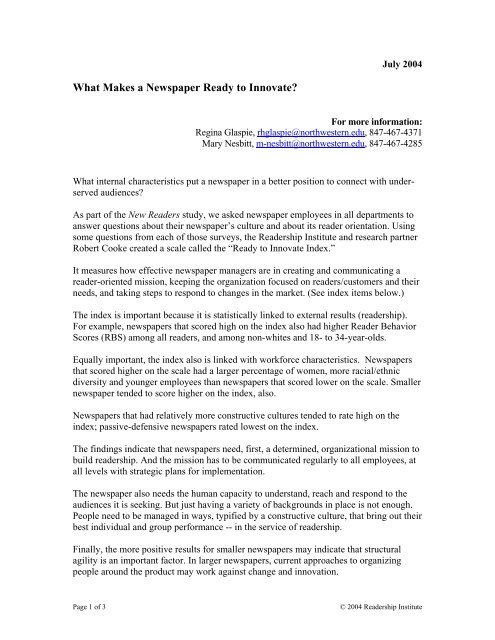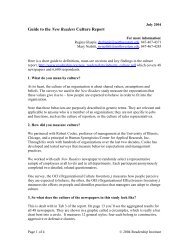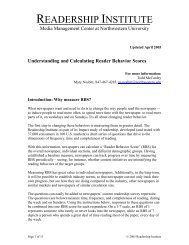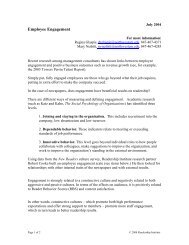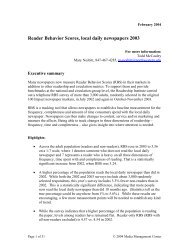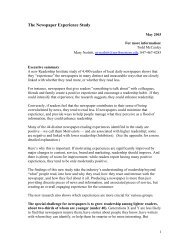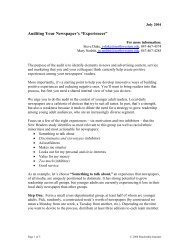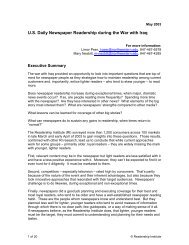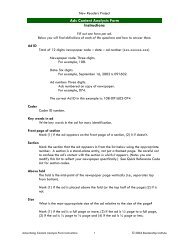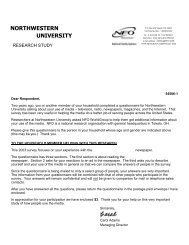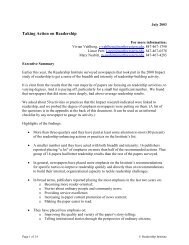What Makes a Newspaper Ready to Innovate? - Readership Institute
What Makes a Newspaper Ready to Innovate? - Readership Institute
What Makes a Newspaper Ready to Innovate? - Readership Institute
You also want an ePaper? Increase the reach of your titles
YUMPU automatically turns print PDFs into web optimized ePapers that Google loves.
July 2004<br />
<strong>What</strong> <strong>Makes</strong> a <strong>Newspaper</strong> <strong>Ready</strong> <strong>to</strong> <strong>Innovate</strong>?<br />
For more information:<br />
Regina Glaspie, rhglaspie@northwestern.edu, 847-467-4371<br />
Mary Nesbitt, m-nesbitt@northwestern.edu, 847-467-4285<br />
<strong>What</strong> internal characteristics put a newspaper in a better position <strong>to</strong> connect with underserved<br />
audiences?<br />
As part of the New Readers study, we asked newspaper employees in all departments <strong>to</strong><br />
answer questions about their newspaper’s culture and about its reader orientation. Using<br />
some questions from each of those surveys, the <strong>Readership</strong> <strong>Institute</strong> and research partner<br />
Robert Cooke created a scale called the “<strong>Ready</strong> <strong>to</strong> <strong>Innovate</strong> Index.”<br />
It measures how effective newspaper managers are in creating and communicating a<br />
reader-oriented mission, keeping the organization focused on readers/cus<strong>to</strong>mers and their<br />
needs, and taking steps <strong>to</strong> respond <strong>to</strong> changes in the market. (See index items below.)<br />
The index is important because it is statistically linked <strong>to</strong> external results (readership).<br />
For example, newspapers that scored high on the index also had higher Reader Behavior<br />
Scores (RBS) among all readers, and among non-whites and 18- <strong>to</strong> 34-year-olds.<br />
Equally important, the index also is linked with workforce characteristics. <strong>Newspaper</strong>s<br />
that scored higher on the scale had a larger percentage of women, more racial/ethnic<br />
diversity and younger employees than newspapers that scored lower on the scale. Smaller<br />
newspaper tended <strong>to</strong> score higher on the index, also.<br />
<strong>Newspaper</strong>s that had relatively more constructive cultures tended <strong>to</strong> rate high on the<br />
index; passive-defensive newspapers rated lowest on the index.<br />
The findings indicate that newspapers need, first, a determined, organizational mission <strong>to</strong><br />
build readership. And the mission has <strong>to</strong> be communicated regularly <strong>to</strong> all employees, at<br />
all levels with strategic plans for implementation.<br />
The newspaper also needs the human capacity <strong>to</strong> understand, reach and respond <strong>to</strong> the<br />
audiences it is seeking. But just having a variety of backgrounds in place is not enough.<br />
People need <strong>to</strong> be managed in ways, typified by a constructive culture, that bring out their<br />
best individual and group performance -- in the service of readership.<br />
Finally, the more positive results for smaller newspapers may indicate that structural<br />
agility is an important fac<strong>to</strong>r. In larger newspapers, current approaches <strong>to</strong> organizing<br />
people around the product may work against change and innovation.<br />
Page 1 of 3<br />
© 2004 <strong>Readership</strong> <strong>Institute</strong>
The <strong>Readership</strong> <strong>Institute</strong> is developing an online assessment <strong>to</strong>ol that would enable a<br />
newspaper <strong>to</strong> determine its readiness <strong>to</strong> innovate, along with suggestions for how <strong>to</strong><br />
improve.<br />
<strong>Ready</strong> <strong>to</strong> <strong>Innovate</strong> Index<br />
The index was created by testing different fac<strong>to</strong>rs from a New Readers culture survey (the<br />
Organizational Effectiveness Inven<strong>to</strong>ry) and from a reader orientation addendum <strong>to</strong> that<br />
survey. Here are the fac<strong>to</strong>rs (in bold) and statements from the surveys (bulleted under<br />
each fac<strong>to</strong>r) that make up the scale.<br />
Mission and Philosophy<br />
• People throughout the organization have a clear understanding of its mission and<br />
its role in the larger community/society.<br />
• The objectives and priorities of this organization are clear and well unders<strong>to</strong>od by<br />
all members.<br />
• Management here holds a widely shared philosophy that provides employees with<br />
a real understanding of what this organization stands for.<br />
• This organization frequently holds ceremonies, informal get-<strong>to</strong>gethers and<br />
meetings <strong>to</strong> celebrate outstanding work by employees, special accomplishments<br />
and similar achievements.<br />
• There are members of this organization (past and present) who are well known <strong>to</strong><br />
employees and whose actions illustrate the philosophy and priorities of the firm.<br />
<strong>Readership</strong> Mission<br />
• I believe this newspaper exists primarily <strong>to</strong> serve readers.<br />
• According <strong>to</strong> <strong>to</strong>p management, serving readers is the most important thing our<br />
newspaper does.<br />
• Readers’ interests always come first, ahead of profitability.<br />
• Increasing the newspaper’s value <strong>to</strong> readers drives our business strategies.<br />
Cus<strong>to</strong>mer Service Orientation<br />
• Your department is responsible for client satisfaction.<br />
• You are encouraged <strong>to</strong> emphasize the perspective and needs of cus<strong>to</strong>mers when<br />
making decisions.<br />
• Your organization relies on you <strong>to</strong> provide information about the preferences and<br />
needs of cus<strong>to</strong>mers.<br />
• The organization relies on you <strong>to</strong> help win cus<strong>to</strong>mers and generate sales.<br />
• The organization responds effectively <strong>to</strong> the changing needs of clients.<br />
Responsiveness (negative items were reversed in analysis)<br />
• For one reason or another, we tend <strong>to</strong> ignore changes in what readers need or want<br />
from us.<br />
• We are slow <strong>to</strong> detect changes in our readers’ preferences.<br />
• Even if our newspaper came up with a great plan <strong>to</strong> build readership, we probably<br />
would not be able <strong>to</strong> implement it in a timely fashion.<br />
Page 2 of 3<br />
© 2004 <strong>Readership</strong> <strong>Institute</strong>
• Internal politics drive the newspaper we sell more than reader needs.<br />
• Reader complaints fall on deaf ears at this newspaper.<br />
• When we find out that readers are unhappy with our newspaper, we take<br />
corrective action immediately.<br />
• Management is open <strong>to</strong> new ideas from employees <strong>to</strong> increase readership.<br />
Adaptability<br />
• New programs and procedures are efficiently and properly implemented when<br />
they are needed.<br />
• This organization proactively identifies and adjusts <strong>to</strong> changes in its business<br />
environment.<br />
• This organization responds effectively <strong>to</strong> external opportunities and threats<br />
Page 3 of 3<br />
© 2004 <strong>Readership</strong> <strong>Institute</strong>


